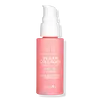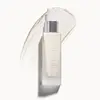What's inside
What's inside
 Key Ingredients
Key Ingredients

 Benefits
Benefits

 Concerns
Concerns

 Ingredients Side-by-side
Ingredients Side-by-side

Water
Skin ConditioningEthylhexyl Olivate
Skin ConditioningStearyl Alcohol
EmollientCetyl Alcohol
EmollientHelianthus Annuus Seed Oil
EmollientCaprylic/Capric Triglyceride
MaskingCoco-Caprylate
EmollientGlyceryl Stearate
EmollientEthyl Macadamiate
Skin ConditioningSr-Hydrozoan Polypeptide-1
HumectantSodium Hyaluronate
HumectantCaffeine
Skin ConditioningCitrus Aurantium Dulcis Flower Extract
Skin ConditioningAstrocaryum Tucuma Seed Butter
EmollientCarthamus Tinctorius Seed Oil
MaskingJasminum Officinale Extract
MaskingTocopherol
AntioxidantSqualane
EmollientPropanediol
SolventCaprylhydroxamic Acid
Caprylyl Glycol
EmollientLauroyl Lysine
Skin ConditioningOctyldodecyl Oleate
EmollientButyrospermum Parkii Butter
Skin ConditioningMica
Cosmetic ColorantTin Oxide
AbrasiveGlycerin
HumectantXanthan Gum
EmulsifyingStearyl Phosphate
EmulsifyingSodium Gluconate
Skin ConditioningCitric Acid
BufferingSodium Hydroxide
BufferingSodium Benzoate
MaskingParfum
MaskingCI 77891
Cosmetic ColorantCI 77491
Cosmetic ColorantWater, Ethylhexyl Olivate, Stearyl Alcohol, Cetyl Alcohol, Helianthus Annuus Seed Oil, Caprylic/Capric Triglyceride, Coco-Caprylate, Glyceryl Stearate, Ethyl Macadamiate, Sr-Hydrozoan Polypeptide-1, Sodium Hyaluronate, Caffeine, Citrus Aurantium Dulcis Flower Extract, Astrocaryum Tucuma Seed Butter, Carthamus Tinctorius Seed Oil, Jasminum Officinale Extract, Tocopherol, Squalane, Propanediol, Caprylhydroxamic Acid, Caprylyl Glycol, Lauroyl Lysine, Octyldodecyl Oleate, Butyrospermum Parkii Butter, Mica, Tin Oxide, Glycerin, Xanthan Gum, Stearyl Phosphate, Sodium Gluconate, Citric Acid, Sodium Hydroxide, Sodium Benzoate, Parfum, CI 77891, CI 77491
Lavandula Angustifolia Flower Water
Skin ConditioningOctyldodecanol
EmollientC10-18 Triglycerides
EmollientOlea Europaea Fruit Oil
MaskingMica
Cosmetic ColorantSqualane
EmollientJojoba Esters
EmollientDisodium Cocoyl Glutamate
CleansingCaprylic/Capric Triglyceride
MaskingHelianthus Annuus Seed Wax
Skin ConditioningTrehalose
HumectantPullulan
Polyglyceryl-6 Distearate
EmulsifyingSodium Hyaluronate
HumectantDioscorea Batatas Extract
AntioxidantAvena Sativa Kernel Extract
AbrasiveSpilanthes Acmella Flower Extract
Skin ConditioningCetyl Alcohol
EmollientPolyglyceryl-3 Beeswax
EmulsifyingAcacia Decurrens Flower Wax
EmollientPolyglycerin-3
HumectantGlycerin
HumectantPollen Extract
EmollientGlycine Soja Oil Unsaponifiables
EmollientOlea Europaea Oil Unsaponifiables
Skin ConditioningTriticum Vulgare Germ Oil Unsaponifiables
EmollientTocopherol
AntioxidantSodium Phytate
Xanthan Gum
EmulsifyingSilver
Cosmetic ColorantGlyceryl Caprylate
EmollientDisodium Capryloyl Glutamate
CleansingSodium Dehydroacetate
PreservativeCitric Acid
BufferingSilica
AbrasiveParfum
MaskingTitanium Dioxide
Cosmetic ColorantCI 77891
Cosmetic ColorantCI 77491
Cosmetic ColorantLavandula Angustifolia Flower Water, Octyldodecanol, C10-18 Triglycerides, Olea Europaea Fruit Oil, Mica, Squalane, Jojoba Esters, Disodium Cocoyl Glutamate, Caprylic/Capric Triglyceride, Helianthus Annuus Seed Wax, Trehalose, Pullulan, Polyglyceryl-6 Distearate, Sodium Hyaluronate, Dioscorea Batatas Extract, Avena Sativa Kernel Extract, Spilanthes Acmella Flower Extract, Cetyl Alcohol, Polyglyceryl-3 Beeswax, Acacia Decurrens Flower Wax, Polyglycerin-3, Glycerin, Pollen Extract, Glycine Soja Oil Unsaponifiables, Olea Europaea Oil Unsaponifiables, Triticum Vulgare Germ Oil Unsaponifiables, Tocopherol, Sodium Phytate, Xanthan Gum, Silver, Glyceryl Caprylate, Disodium Capryloyl Glutamate, Sodium Dehydroacetate, Citric Acid, Silica, Parfum, Titanium Dioxide, CI 77891, CI 77491
 Reviews
Reviews

Ingredients Explained
These ingredients are found in both products.
Ingredients higher up in an ingredient list are typically present in a larger amount.
This ingredient is an emollient, solvent, and texture enhancer. It is considered a skin-softener by helping the skin prevent moisture loss.
It helps thicken a product's formula and makes it easier to spread by dissolving clumping compounds.
Caprylic Triglyceride is made by combining glycerin with coconut oil, forming a clear liquid.
While there is an assumption Caprylic Triglyceride can clog pores due to it being derived from coconut oil, there is no research supporting this.
Learn more about Caprylic/Capric TriglycerideCetyl Alcohol is a fatty alcohol. Fatty Alcohols are most often used as an emollient or to thicken a product.
Its main roles are:
Though it has "alcohol" in the name, it is not related to denatured alcohol or ethyl alcohol.
The FDA allows products labeled "alcohol-free" to have fatty alcohols.
Learn more about Cetyl AlcoholCi 77491 is also hydrated iron III oxide. It's sole purpose is to give a red/pink hue to products.
Iron III oxides are classified as inorganic chemicals for coloring.
Synthetically created Ci 77491 is considered safer than those naturally found. This is because the synthetically created version may contain less impurities. Iron oxides are generally non-toxic and non-allergenic.
Learn more about CI 77491Ci 77891 is a white pigment from Titanium dioxide. It is naturally found in minerals such as rutile and ilmenite.
It's main function is to add a white color to cosmetics. It can also be mixed with other colors to create different shades.
Ci 77891 is commonly found in sunscreens due to its ability to block UV rays.
Learn more about CI 77891Citric Acid is an alpha hydroxy acid (AHA) naturally found in citrus fruits like oranges, lemons, and limes.
Like other AHAs, citric acid can exfoliate skin by breaking down the bonds that hold dead skin cells together. This helps reveal smoother and brighter skin underneath.
However, this exfoliating effect only happens at high concentrations (20%) which can be hard to find in cosmetic products.
Due to this, citric acid is usually included in small amounts as a pH adjuster. This helps keep products slightly more acidic and compatible with skin's natural pH.
In skincare formulas, citric acid can:
While it can provide some skin benefits, research shows lactic acid and glycolic acid are generally more effective and less irritating exfoliants.
Most citric acid used in skincare today is made by fermenting sugars (usually from molasses). This synthetic version is identical to the natural citrus form but easier to stabilize and use in formulations.
Read more about some other popular AHA's here:
Learn more about Citric AcidGlycerin is already naturally found in your skin. It helps moisturize and protect your skin.
A study from 2016 found glycerin to be more effective as a humectant than AHAs and hyaluronic acid.
As a humectant, it helps the skin stay hydrated by pulling moisture to your skin. The low molecular weight of glycerin allows it to pull moisture into the deeper layers of your skin.
Hydrated skin improves your skin barrier; Your skin barrier helps protect against irritants and bacteria.
Glycerin has also been found to have antimicrobial and antiviral properties. Due to these properties, glycerin is often used in wound and burn treatments.
In cosmetics, glycerin is usually derived from plants such as soybean or palm. However, it can also be sourced from animals, such as tallow or animal fat.
This ingredient is organic, colorless, odorless, and non-toxic.
Glycerin is the name for this ingredient in American English. British English uses Glycerol/Glycerine.
Learn more about GlycerinMica is a naturally occurring mineral used to add shimmer and color in cosmetics. It can also help improve the texture of a product or give it an opaque, white/silver color.
Serecite is the name for very fine but ragged grains of mica.
This ingredient is often coated with metal oxides like titanium dioxide. Trace amounts of heavy metals may be found in mica, but these metals are not harmful in our personal products.
Mica has been used since prehistoric times throughout the world. Ancient Egyptian, Indian, Greek, Roman, Aztec, and Chinese civilizations have used mica.
Learn more about MicaParfum is a catch-all term for an ingredient or more that is used to give a scent to products.
Also called "fragrance", this ingredient can be a blend of hundreds of chemicals or plant oils. This means every product with "fragrance" or "parfum" in the ingredients list is a different mixture.
For instance, Habanolide is a proprietary trade name for a specific aroma chemical. When used as a fragrance ingredient in cosmetics, most aroma chemicals fall under the broad labeling category of “FRAGRANCE” or “PARFUM” according to EU and US regulations.
The term 'parfum' or 'fragrance' is not regulated in many countries. In many cases, it is up to the brand to define this term.
For instance, many brands choose to label themselves as "fragrance-free" because they are not using synthetic fragrances. However, their products may still contain ingredients such as essential oils that are considered a fragrance by INCI standards.
One example is Calendula flower extract. Calendula is an essential oil that still imparts a scent or 'fragrance'.
Depending on the blend, the ingredients in the mixture can cause allergies and sensitivities on the skin. Some ingredients that are known EU allergens include linalool and citronellol.
Parfum can also be used to mask or cover an unpleasant scent.
The bottom line is: not all fragrances/parfum/ingredients are created equally. If you are worried about fragrances, we recommend taking a closer look at an ingredient. And of course, we always recommend speaking with a professional.
Learn more about ParfumSodium Hyaluronate is hyaluronic acid's salt form. It is commonly derived from the sodium salt of hyaluronic acid.
Like hyaluronic acid, it is great at holding water and acts as a humectant. This makes it a great skin hydrating ingredient.
Sodium Hyaluronate is naturally occurring in our bodies and is mostly found in eye fluid and joints.
These are some other common types of Hyaluronic Acid:
Learn more about Sodium HyaluronateSqualane is an emollient that helps the skin hold onto moisture. It's an oily liquid that occurs naturally in certain types of fish and plant oils.
Because squalane boosts hydration in the skin, it also comes with plenty of benefits: it is an antioxidant and can help fight free radicals and skin damage. Squalane is also found to have a detoxifying effect when applied.
Squalane comes from squalene, which occurs naturally within the sebum of our skin. It is one of the oils our skin produces to keep itself hydrated. Squalane is the hydrogenated version of squalene and has a longer shelf life.
Research shows that squalane is non-irritating (even at 100% concentration).
In general, it's a fantastic ingredient. It does a great job at hydrating the skin, and it's suitable for those with sensitive skin.
The source of squalane may impact malassezia / fungal acne. This is because olive oil derived squalane can contain impurities such as fatty acids and plant waxes. Sugarcane derived squalane is recommended for anyone with malassezia concerns.
Is squalane vegan?
This depends on the source. Squalane can be derived from both plants and animals. Most squalane used in skincare comes from plants.
Please note: the source of squalane is only known if disclosed by the brand. We recommend reaching out to the brand if you have any questions about their squalane.
Read more about squalene with an "e".
Is squalane an oil?
Squalane is often called an oil, but it’s technically not; it’s a hydrocarbon, meaning it’s only made of carbon and hydrogen, unlike true oils which are triglycerides made of fatty acids and glycerol.
The term “oil-free” isn’t regulated, so companies can define it however they want. Some exclude all oils, while others just avoid mineral oil or comedogenic oils.
While some people avoid oils thinking they cause breakouts, the right kind of oil (or oil-like ingredient like squalane) can actually help balance and hydrate your skin. It’s worth testing out simple oils or squalane to see what works best for your skin.
Learn more about SqualaneTocopherol (also known as Vitamin E) is a common antioxidant used to help protect the skin from free-radicals and strengthen the skin barrier. It's also fat soluble - this means our skin is great at absorbing it.
Vitamin E also helps keep your natural skin lipids healthy. Your lipid skin barrier naturally consists of lipids, ceramides, and fatty acids. Vitamin E offers extra protection for your skin’s lipid barrier, keeping your skin healthy and nourished.
Another benefit is a bit of UV protection. Vitamin E helps reduce the damage caused by UVB rays. (It should not replace your sunscreen). Combining it with Vitamin C can decrease sunburned cells and hyperpigmentation after UV exposure.
You might have noticed Vitamin E + C often paired together. This is because it is great at stabilizing Vitamin C. Using the two together helps increase the effectiveness of both ingredients.
There are often claims that Vitamin E can reduce/prevent scarring, but these claims haven't been confirmed by scientific research.
Learn more about TocopherolXanthan gum is used as a stabilizer and thickener within cosmetic products. It helps give products a sticky, thick feeling - preventing them from being too runny.
On the technical side of things, xanthan gum is a polysaccharide - a combination consisting of multiple sugar molecules bonded together.
Xanthan gum is a pretty common and great ingredient. It is a natural, non-toxic, non-irritating ingredient that is also commonly used in food products.
Learn more about Xanthan Gum